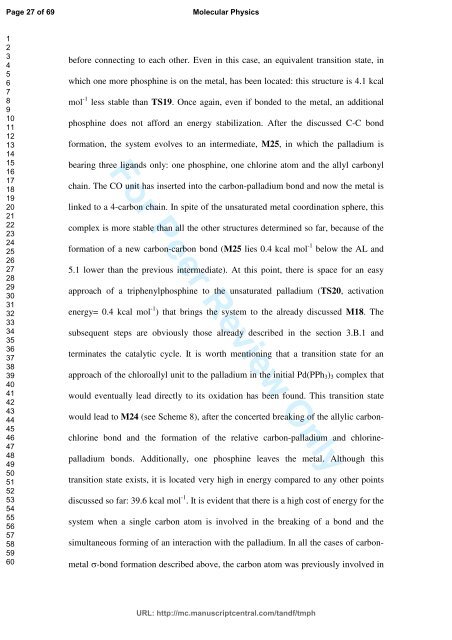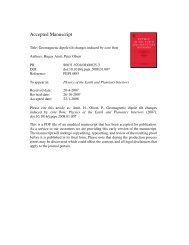For Peer Review Only - TARA
For Peer Review Only - TARA
For Peer Review Only - TARA
Create successful ePaper yourself
Turn your PDF publications into a flip-book with our unique Google optimized e-Paper software.
Page 27 of 69<br />
Molecular Physics<br />
1<br />
2<br />
3<br />
4<br />
5<br />
6<br />
7<br />
8<br />
9<br />
10<br />
11<br />
12<br />
13<br />
14<br />
15<br />
16<br />
17<br />
18<br />
19<br />
20<br />
21<br />
22<br />
23<br />
24<br />
25<br />
26<br />
27<br />
28<br />
29<br />
30<br />
31<br />
32<br />
33<br />
34<br />
35<br />
36<br />
37<br />
38<br />
39<br />
40<br />
41<br />
42<br />
43<br />
44<br />
45<br />
46<br />
47<br />
48<br />
49<br />
50<br />
51<br />
52<br />
53<br />
54<br />
55<br />
56<br />
57<br />
58<br />
59<br />
60<br />
before connecting to each other. Even in this case, an equivalent transition state, in<br />
which one more phosphine is on the metal, has been located: this structure is 4.1 kcal<br />
mol -1 less stable than TS19. Once again, even if bonded to the metal, an additional<br />
phosphine does not afford an energy stabilization. After the discussed C-C bond<br />
formation, the system evolves to an intermediate, M25, in which the palladium is<br />
<strong>For</strong> <strong>Peer</strong> <strong>Review</strong> <strong>Only</strong><br />
bearing three ligands only: one phosphine, one chlorine atom and the allyl carbonyl<br />
chain. The CO unit has inserted into the carbon-palladium bond and now the metal is<br />
linked to a 4-carbon chain. In spite of the unsaturated metal coordination sphere, this<br />
complex is more stable than all the other structures determined so far, because of the<br />
formation of a new carbon-carbon bond (M25 lies 0.4 kcal mol -1 below the AL and<br />
5.1 lower than the previous intermediate). At this point, there is space for an easy<br />
approach of a triphenylphosphine to the unsaturated palladium (TS20, activation<br />
energy= 0.4 kcal mol -1 ) that brings the system to the already discussed M18. The<br />
subsequent steps are obviously those already described in the section 3.B.1 and<br />
terminates the catalytic cycle. It is worth mentioning that a transition state for an<br />
approach of the chloroallyl unit to the palladium in the initial Pd(PPh 3 ) 3 complex that<br />
would eventually lead directly to its oxidation has been found. This transition state<br />
would lead to M24 (see Scheme 8), after the concerted breaking of the allylic carbonchlorine<br />
bond and the formation of the relative carbon-palladium and chlorinepalladium<br />
bonds. Additionally, one phosphine leaves the metal. Although this<br />
transition state exists, it is located very high in energy compared to any other points<br />
discussed so far: 39.6 kcal mol -1 . It is evident that there is a high cost of energy for the<br />
system when a single carbon atom is involved in the breaking of a bond and the<br />
simultaneous forming of an interaction with the palladium. In all the cases of carbonmetal<br />
σ-bond formation described above, the carbon atom was previously involved in<br />
URL: http://mc.manuscriptcentral.com/tandf/tmph
















